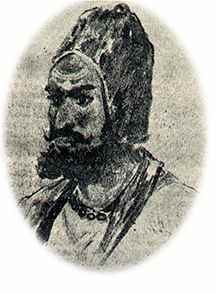Namdhari Shaheeds -
Foremost Freedom Fighters-Page 4


He contacted the Russian authorities, in Russian Turkistan. The Namdhari emissaries, Baba Gurcharan Singh, who was well versed in Pashto and Persian languages, Shankar Rai, Maya and Budh Singh, acted as carriers of letters between Russians and Guru Ram Singh confined in Rangoon jail. The British officials were greatly perturbed, when the fact of the secret communication carried on between Russians and the Kukas, was revealed. Colonel Cavengri sent his secret agent to Central Asia to unearth the plot. Later on, Gurcharan Singh was arrested in 1880 and detained in Multan jail under Bengal Regulation III of 1818. Guru Ram Singh was removed from Rangoon to Mergui and kept under a heavy guard.
During the famine of 1881-82, Guru Hari Singh distri-buted free food to famine-stricken people, who had gathered in thousands at Bhaini. The British officers, in order to win and appease Namdharies and their Guru, offered to attach 2500 acres of land to his LANGAR, or free kitchen. Guru Hari Singh declined the offer saying , "So long as God sends me grains, I will distribute free food to needy, and when there are no grains, I will also join the needy ones in their wanderings for food and try to procure it for them elsewhere".
For 21 years, Guru Han Singh was not allowed to move out from his Headquarters, without the previous sanction of the Government. The sanction was given only on a few occasions.
Guru Han Singh breathed his last in 1906 and was succeeded by Guru Partap Singh Ji Maharaj. During the First World War of 1914, the British Govern-ment once again tried to appease the Namdharies by offering vast landed grants to Sri Satguru Ji and his followers, if he could only make a non-committal statement in favour of recruitment. The Government also offered to remove all restrictions on him and the Namdharies. The offers were declined scornfully.
At the time when the Indian National Congress, under the leadership of Mahatma Gandhi, adopted the programme of Swedshi, Non-co-operation, and Boycott, the Namdharies joined the organisation on mass. The Namdharies had been following such a programme since 1857. For all these years they have steadfastly stood by the Congress organisation sharing its sorrows, trials and ordeals, but not its gains.
Namdharies are strictly vegetarian in diet. Their women folk enjoy equal rights. They are enjoined upon to adhere to the cult of Swedeshi. They are strictly forbidden to enjoy luxuries of life. On marriage and other occasions in the family, no Namdhari is allowed to spend more than Rs. 13/~. In the matter of marriage they do not believe in caste restrictions. Men of all castes are permitted to join the Namdhari faith. Truthfulness, simplicity in thought and action, righteousness, adoption of fair and honest means for earning livelihood, giving one tenth of income in charity, helping the poor and needy; service of fellow beings in distress, and willingness to make sacrifice for the sake of Motherland, are the main tenets of the Namdhari faith.
